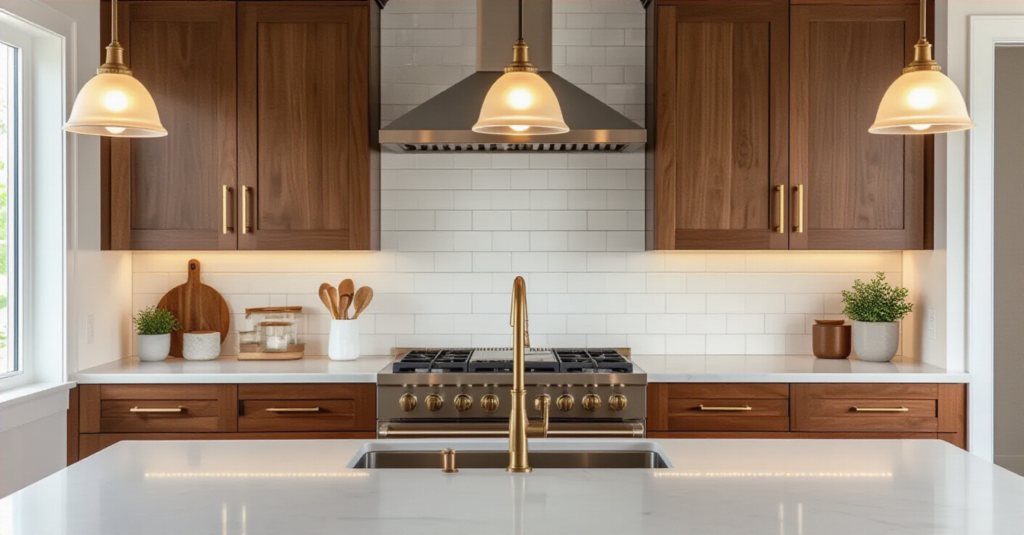Can we please have a word about brown? You know what people always ask me? They worry it’s dated. Boring. A bit… seventies. And I understand. The 1970s, with its love of questionable avocado and murky rust, did the entire colour family a terrible disservice. But to dismiss brown is to dismiss the comforting gravitas of a Georgian library, the rich patina of an old leather Chesterfield, or the earthy warmth of a perfectly baked loaf of bread.
True brown—in shades of walnut, chocolate, oak, and tan—is not a trend. It’s a foundation. It’s the secret to creating a kitchen that feels not just designed, but gathered. It’s sophisticated, warm, and deeply reassuring. So let’s dispense with the notion that brown is anything but brilliant. The real trick isn’t if you should use it, but how. Most of the advice out there is noise—a muddle of resale value percentages and sterile design rules. What truly matters is layering tone and texture to create a space that feels like a warm embrace.
I once worked with a client in Notting Hill who was terrified of her north-facing kitchen feeling like a cave. We leaned into the challenge, choosing a deep walnut for the cabinets and, rather than fighting the lack of light, we amplified the warmth with strategic lighting and acres of burnished brass. The result wasn’t a cave; it was a cocoon. A jewel-box of a room that glowed from within. That’s the power of doing brown properly. Forget the corporate speak; here is how you actually create a brown kitchen that feels both timeless and utterly of the moment.
Foundational Brown Elements: Setting Your Core Palette
Right, first things first. Before you start collecting swatches for scatter cushions, you must get the bones of the room right. These are the big, expensive decisions—the cabinetry, the floors, the worktops. Get these correct, and the rest is simply styling. Get them wrong, and you’ll be fighting an uphill battle forevermore.
1. Select Warm Walnut Cabinets for Enduring Elegance
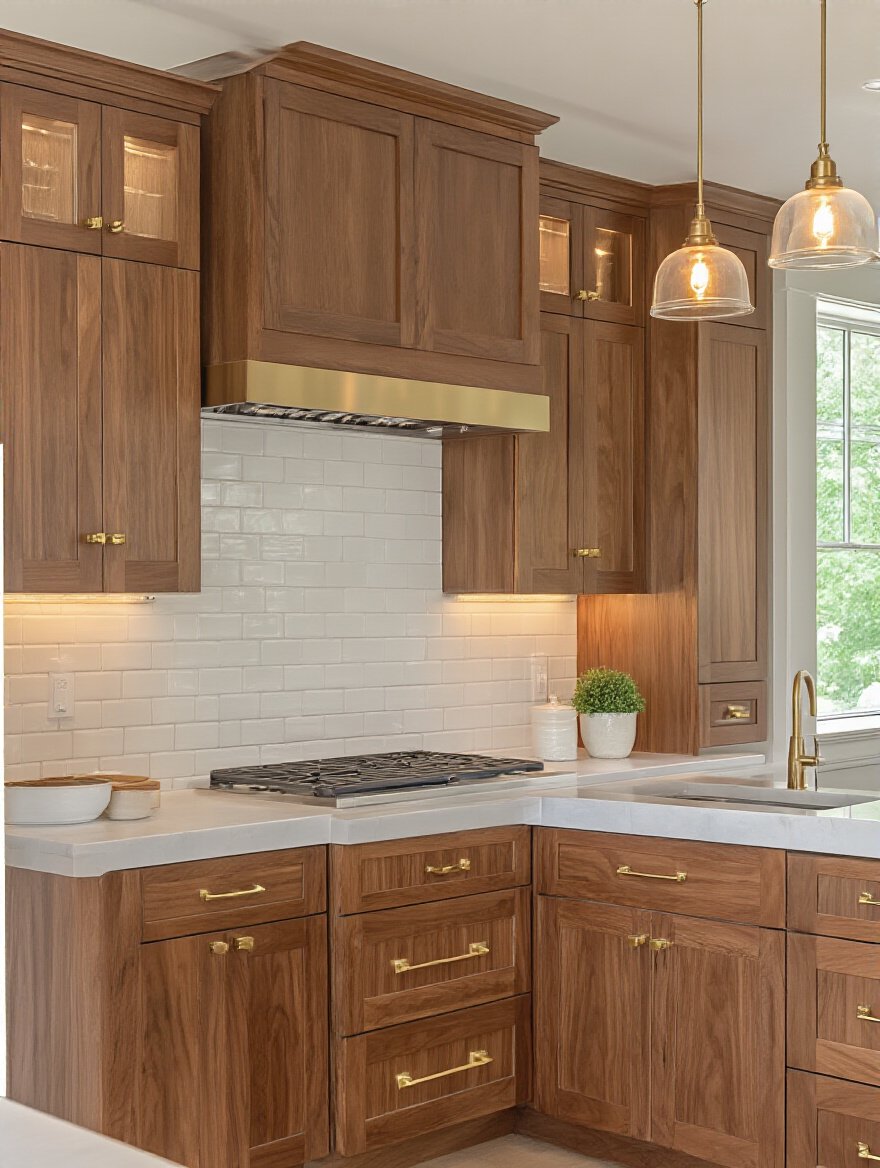
Walnut is what I call a “forever wood.” It possesses a quiet, confident luxury that simply does not go out of style. Think of the beautiful antique furniture at the V&A; much of it is walnut, and it looks as elegant today as it did centuries ago. Choosing walnut cabinets provides a rich, complex foundation with deep, sometimes purplish, undertones that offer instant history and gravitas to a kitchen.
Forget the flimsy trends that come and go. Investing in well-made walnut cabinetry is an investment in permanence. It’s the antithesis of “fast fashion” for interiors. The key is to let the wood be the star. Don’t slather it in a dark, opaque stain. Use a clear finish that allows the natural grain and its beautiful variations to shine through. And for heaven’s sake, pair it with something light—a pale marble or quartz worktop, a simple ceramic tile—to keep it from feeling like a Victorian gentleman’s club.
From the enduring grace of walnut, we can pivot to its moodier, more contemporary cousin: espresso.
2. Embrace Rich Espresso Cabinetry for Modern Sophistication
Now, a word of caution. I had a client—lovely man, but with more enthusiasm than sense—who fell in love with espresso cabinets after seeing them in a slick design magazine. He installed them floor-to-ceiling without considering his lighting. The result was less “modern sophistication” and more “sentient void.” It quite literally swallowed light. We fixed it, of course, but it taught me a valuable lesson. Espresso is a bold, dramatic choice that needs a counterpoint.

This is the shortcut I wish he’d known: if you go dark, you must go brilliantly light everywhere else. Think reflective backsplashes, dazzling white quartz worktops that waterfall over the island, and a lighting plan that could illuminate a small village. People will tell you dark colours are low-maintenance. This is a fib. A dark, glossy cabinet will show every fingerprint and speck of flour. But if you’re prepared for that, and you balance it correctly, espresso cabinetry creates a fantastically dramatic and urbane backdrop that makes everything else in the room pop.
Let’s now step away from the drama and into something a little more serene and airy.
3. Opt for Light Oak Lowers to Create an Airy, Grounded Feel
This is a terribly chic look one sees in smart London mews houses—a kitchen that feels both modern and rooted in nature. By keeping the lower, or base, cabinets in a beautiful light oak and using something else for the uppers—often just a simple, painted finish or open shelving—you get the best of both worlds. The oak grounds the space with its warmth and organic texture, while the absence of heavy, dark upper cabinets keeps the room feeling light and spacious.
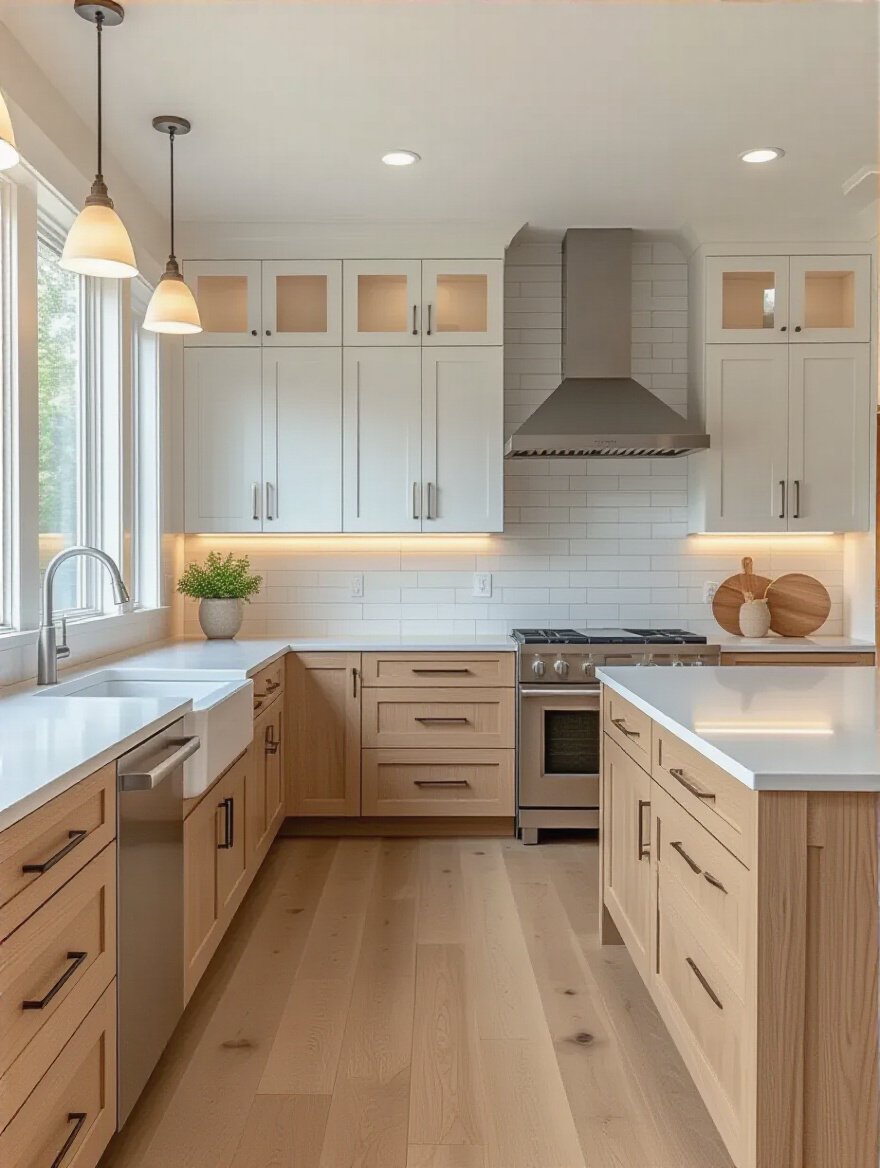
This is the perfect compromise for those who are a bit timid about committing to an all-brown kitchen. It’s a way to introduce the warmth of wood without sacrificing that bright, airy feeling that so many of us crave. The key is to choose the right oak. You want a rift-sawn or quarter-sawn white oak for its clean, linear grain, which feels contemporary. Avoid anything that looks too rustic or leans towards that unfortunate orange tone of 1990s joinery.
With the lower half of the room grounded, let’s consider what’s happening underfoot.
4. Anchor Your Space with Deep Tone Hardwood Flooring
There is something undeniably satisfying about a dark wood floor. It provides a solid, visual anchor for the entire room, making everything placed upon it feel more significant and intentional. A deep-toned floor in walnut, or a darkly stained oak, makes white cabinetry look crisper, metallic accents look richer, and creates a sense of continuity, especially in an open-plan home. It’s the strong, silent type of kitchen flooring.
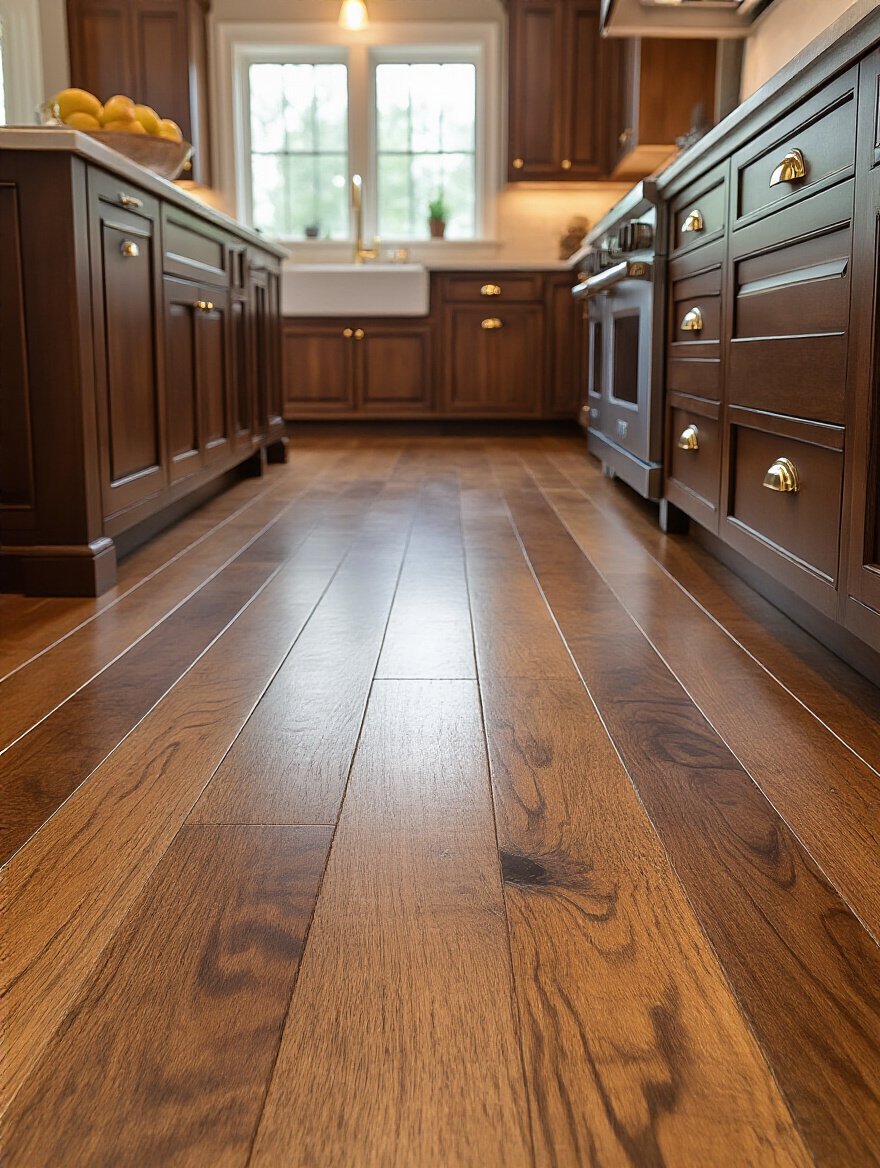
Don’t let anyone tell you that dark floors make a room feel smaller. It’s simply not true. What they do is create depth and a sense of history. The shortcut here is to choose a finish with a low sheen. A matte or satin finish is far more forgiving of daily life than a high-gloss polish, which will show every scratch and scuff. And run the boards parallel to the longest wall or the main source of light; it’s an old trick that subtly enhances the sense of space and flow.
Now, let’s move up to the surfaces where all the culinary magic happens.
5. Incorporate Durable Brown Granite Countertops for Organic Texture
Let’s be honest, brown granite got a bit of a bad reputation in the early 2000s, didn’t it? Everyone remembers those speckled, busy countertops that screamed “developer special.” But a carefully chosen slab of brown granite can be a thing of immense beauty. Look for stones with movement and character—sweeping veins and rich, earthy deposits that look more like a piece of abstract art than a polka-dot pattern.

The beauty of granite is its organic, one-of-a-kind nature. It brings a piece of the earth right into your home. A beautiful brown granite can be the perfect bridge between, say, dark lower cabinets and creamy white uppers. The secret is to go and choose your slab in person. Don’t just pick from a tiny sample. You need to see the whole glorious piece to appreciate its personality. And please, install under-cabinet lighting. It will bring all those beautiful mineral flecks and veins to life.
Having set down our foundations, it’s time for the really clever part: layering.
Layering Textures & Tones: Adding Depth to Your Brown Kitchen
This is where a good kitchen becomes a great one. A room designed with only one shade of brown and one texture is flat and uninspired. The real artistry lies in weaving together a tapestry of different tones, materials, and finishes to create a space that has soul and complexity. It’s the difference between a photograph and a painting.
6. Design a Statement Island Using Reclaimed Barn Wood
There is a soul to reclaimed wood that new timber simply cannot replicate. Every knot, nail hole, and water stain tells a story. Using reclaimed barn wood to clad a Kitchen Island instantly makes it the heart and soul of the room—a characterful, rustic anchor that feels both authentic and incredibly warm. It’s the perfect foil for sleeker, more modern elements elsewhere in the kitchen.

But do be practical. This isn’t just about finding some old planks. The shortcut to getting this right is to source your wood from a reputable dealer who ensures it’s been properly de-nailed, kiln-dried (to prevent warping and unwelcome critters), and sealed. You want the history, not the splinters. Pairing it with a quiet, modern worktop like honed black granite or a simple white quartz allows the wood to be the star without creating a look that is overly “farmhouse.”
From the rustic soul of the English countryside, let’s journey to the sun-baked warmth of the Mediterranean.
7. Install Rustic Terra Cotta Tile Backsplash for Mediterranean Warmth
Terra cotta is just sunshine in a tile. Its earthy, red-brown tones bring an immediate, soulful warmth to a kitchen, evoking a rambling Tuscan farmhouse or a sun-drenched Spanish villa. As a backsplash, it’s a brilliant way to add texture and a handcrafted feel that prevents a brown kitchen from feeling too severe or formal. The slight irregularities in handmade tiles are part of their charm.

A word to the wise: terra cotta is porous. This is non-negotiable. You must have your tiles sealed before they are installed and grouted. I once had to console a tearful client who ignored this advice and ended up with a backsplash that absorbed a splash of bolognese sauce like a sponge. Seal it properly, and it will be a durable and beautiful feature for decades. Neglect to do so, and you will live in a constant state of low-grade anxiety.
From the handcrafted charm of clay, we move to its sleek, modern-day descendant.
8. Choose Sleek Brown Quartz Countertops for a Seamless Modern Look
For those of us who adore the idea of natural materials but perhaps lack the patience for their eccentricities, brown quartz is a magnificent, pragmatic choice. It offers the warmth and depth of a brown stone but with none of the maintenance. No sealing, no worrying about an errant splash of lemon juice. It is uniform, predictable, and practically indestructible—the stoic, reliable friend in your kitchen design.
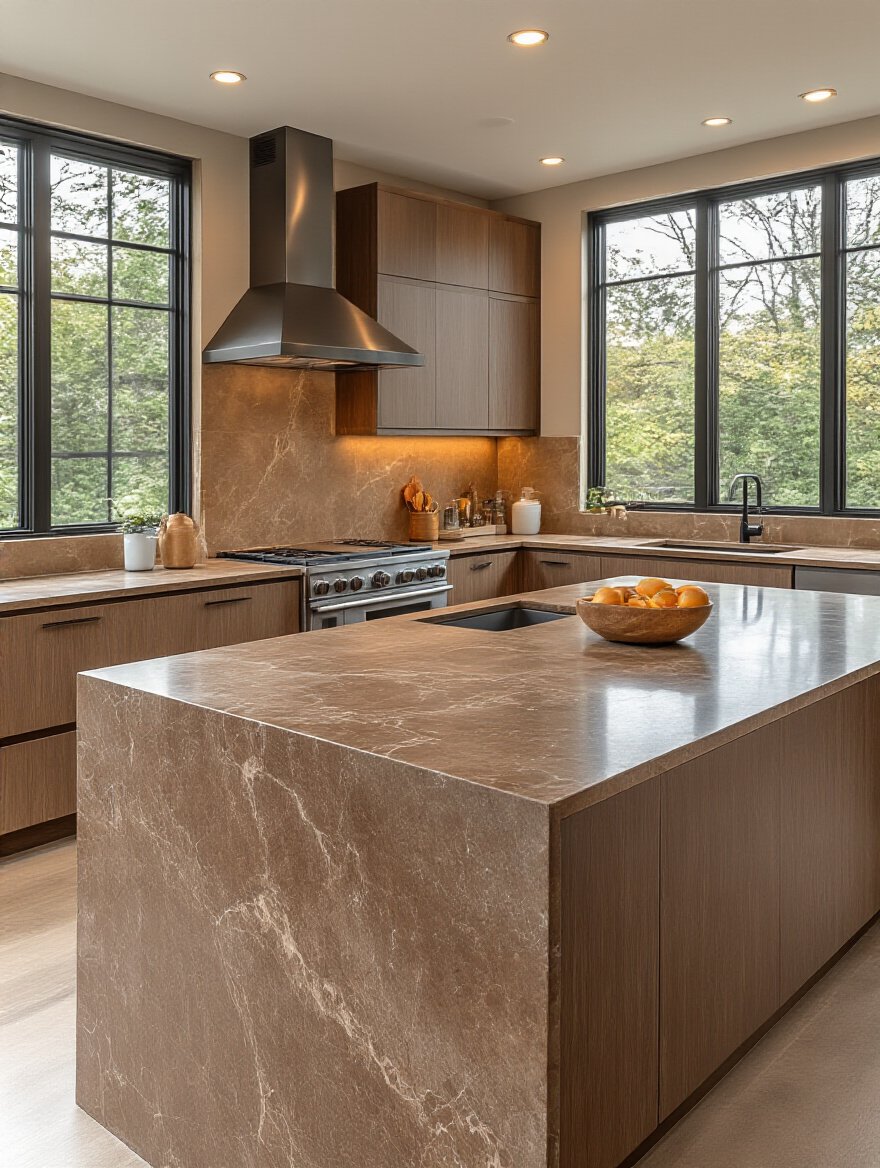
The real trick to making quartz look its most luxurious is to aim for a seamless appearance. This is where you can do a beautiful waterfall edge, where the material flows from the top of the island right down the side to the floor. It creates a monolithic, sculptural effect that is incredibly chic and modern. And because quartz is engineered, you can get a perfect pattern match, something that is nearly impossible with the glorious chaos of natural stone.
Let’s now turn our eyes upwards and break up those solid blocks of cabinetry.
9. Introduce Open Shelving with Natural Wood for Display & Warmth
I love open shelving, but let’s be brutally honest: it’s not for the untidy. It’s for displaying your most beautiful, curated objects—a domestic still life of stacked white plates, a few well-chosen glasses, and a pot of fresh herbs. It’s a stage. Using shelves made from a beautiful natural wood, like oak or maple, is a fantastic way to break up a wall of solid cabinetry and inject a layer of warmth and personality into a brown kitchen.
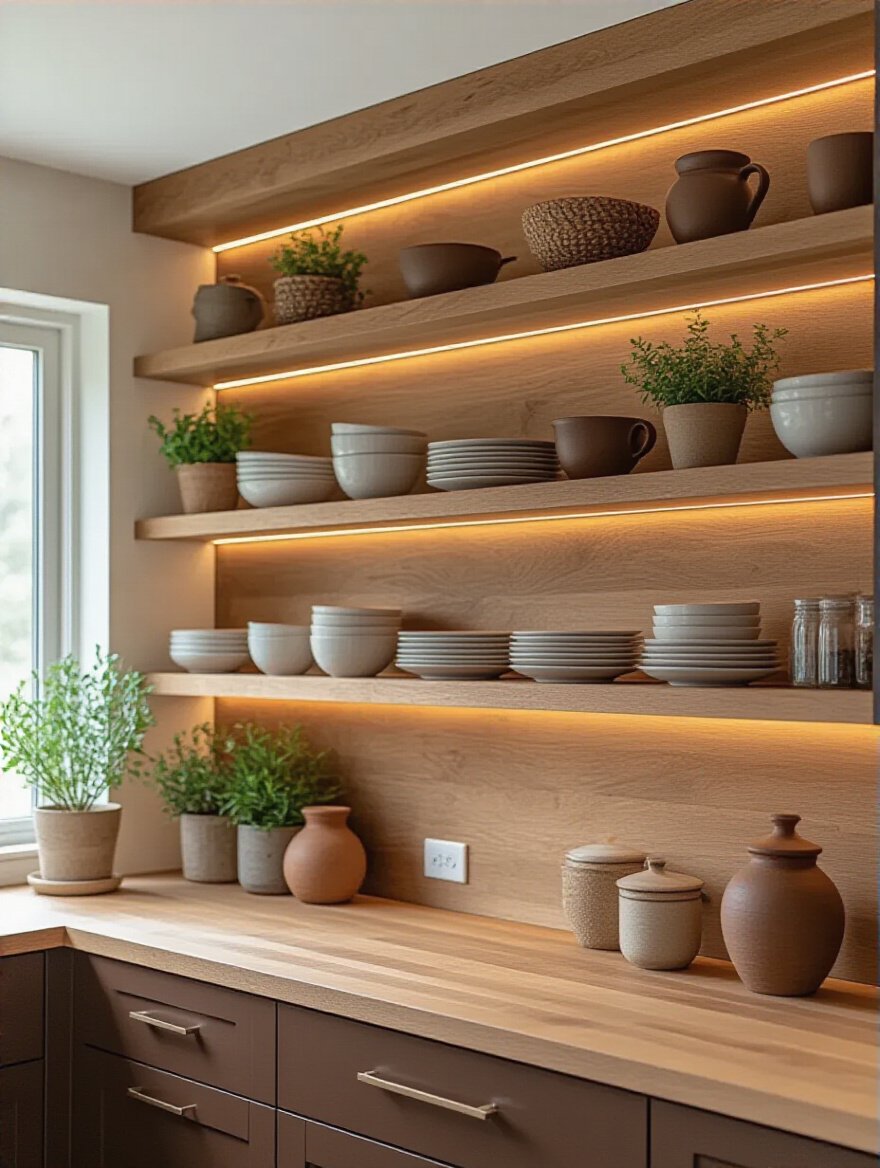
It prevents the dreaded “wall of brown” and makes the space feel lighter and more personal. The shortcut to styling them is what designers call the ‘Rule of Three’. Group items in odd numbers—threes or fives—and vary their height and texture. A stack of books, a small ceramic bowl, a trailing plant. It creates a composition that feels balanced and effortless, even though we know it took a bit of fiddling to get just right.
From wood, we turn to paper for another textural trick up our sleeve.
10. Create a Cozy Feature Wall with Textured Brown Wallpaper
This is a wonderful strategy for those who might be renting or are a bit shy about making permanent changes. Creating a feature wall with a textured wallpaper—think grasscloth, a subtle linen-weave, or even a faux suede—in a rich brown hue can add incredible depth and intimacy to a kitchen nook or the wall behind a banquette. It’s an instant dose of cozy sophistication.
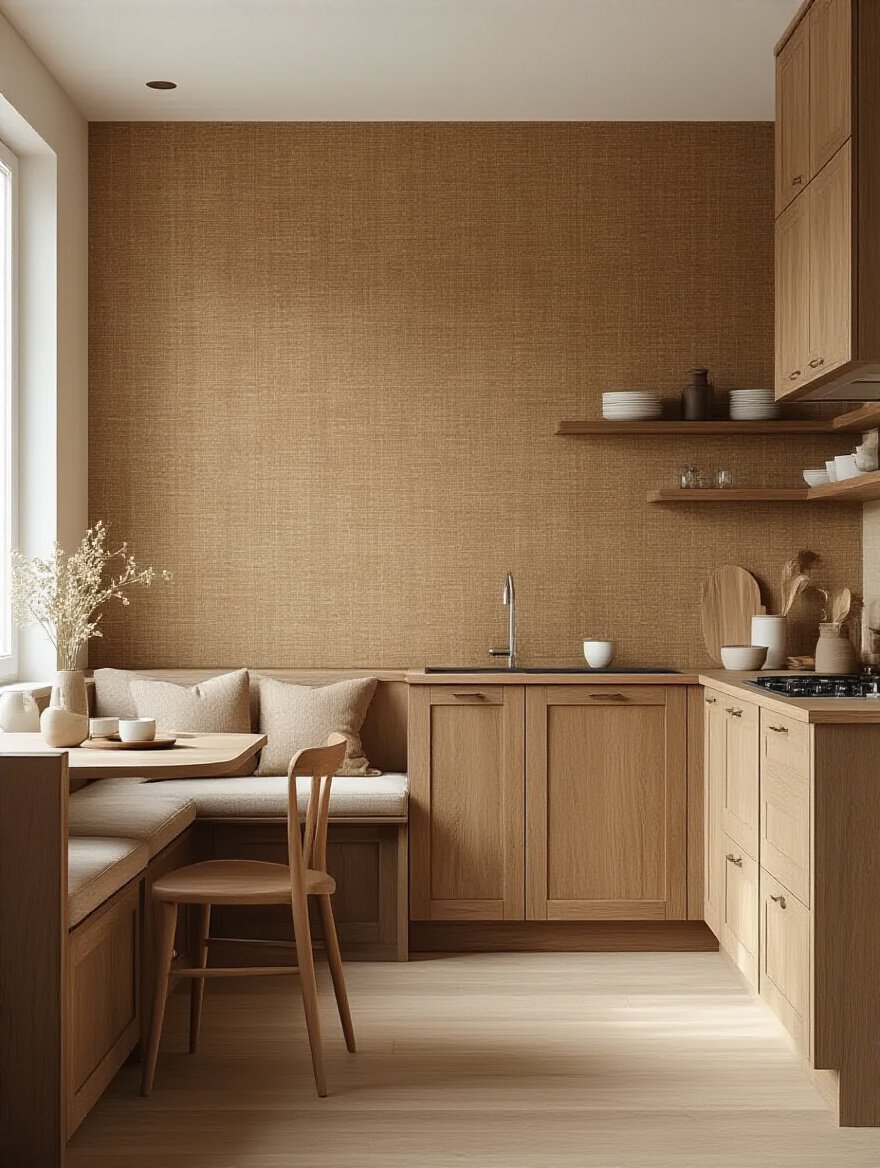
A textured surface does something magical with light, absorbing and reflecting it in a way that creates soft shadows and a real tactile quality. It makes a room feel more expensive and considered. The trick is to choose the right wall. You want a single, uninterrupted surface for the greatest impact. Avoid walls that are cluttered with too many doors, windows, or switches, as it will just look messy.
Now that we’ve mastered texture, let’s talk about the nuances of tone.
11. Pair Light and Dark Browns for Dynamic Visual Interest
A kitchen decorated in a single shade of brown risks being, well, a bit dull. The true mark of a sophisticated design is the confident layering of different tones. It’s a technique that creates depth, contrast, and keeps the eye moving around the room. Think of pairing rich, dark chocolate brown lower cabinets with a lighter, mushroom-toned paint on the walls, or a sandy beige stone floor with a deep walnut island.

This is a design principle, not just a suggestion. The dark tones ground the space, giving it weight and presence, while the lighter tones lift it, creating a sense of airiness. It’s this “push and pull” that creates a dynamic and engaging interior. You can then bridge the gap with mid-tones in your textiles, accessories, or a veined worktop that contains a spectrum of browns within it.
With the main layers in place, we move on to the supporting cast—the elements that make our brown sing.
Complementary Accents: Pairing Brown with Other Elements
A brown kitchen left to its own devices can feel a bit solitary. It needs companions to bring out its best qualities. These are the accent colours and materials that provide contrast, light, and personality. Think of them as the perfect accessories for a beautifully tailored brown suit.
12. Brighten Brown with Crisp White Countertops and Backsplashes
This is perhaps the most classic and foolproof pairing in the design lexicon. It is the perfect marriage of warmth and freshness. The rich, earthy quality of brown cabinetry is beautifully offset by the clean, bright clarity of a white worktop and backsplash. This high-contrast look prevents the brown from feeling heavy and makes the entire kitchen feel more spacious and luminous.

This is not the place for a creamy, muddled white. You want a crisp, brilliant white to create that sharp, graphic contrast. A polished white quartz or a classic Carrara marble works wonders. One of my favourite shortcuts for an impossibly chic look is to use the same material for both the worktop and the full-height backsplash. It creates a seamless, monolithic plane of brightness that is both dramatic and utterly timeless.
Let’s stay with the whites, but soften the edges just a little.
13. Soften the Palette Using Cream or Off-White Wall Paint
If crisp white is the sharp, witty friend, cream is the warm, comforting one. Painting the walls in a soft cream or a complex off-white is a superb way to complement brown cabinetry without creating the stark contrast of a pure white. These shades have warm undertones that harmonize beautifully with wood, creating a gentle, light-filled envelope for the room.
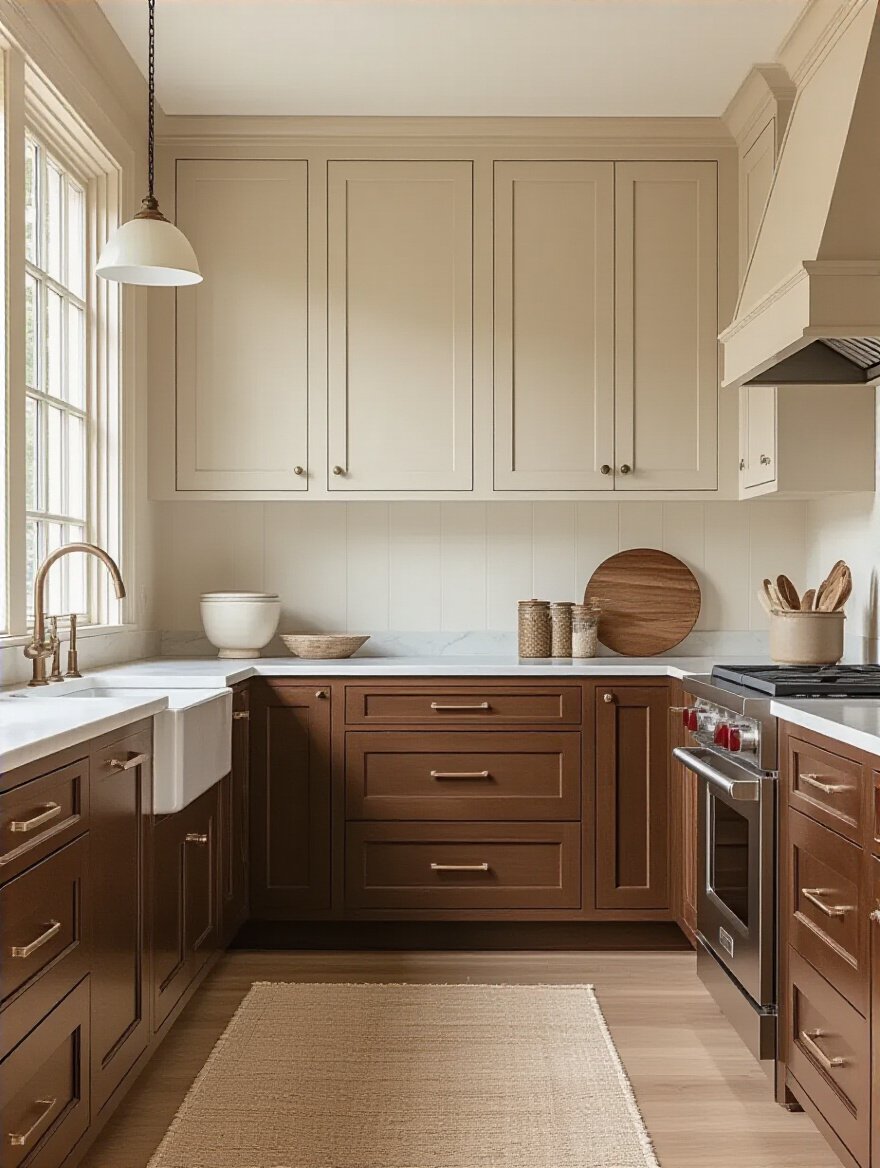
The most critical advice I can give you is to test your paint samples. Never, ever choose a colour from a tiny card under the harsh fluorescent lights of a shop. Paint large swatches on your walls and observe how they change with the natural light throughout the day. A cream that looks perfect in the morning might look a bit sallow by teatime. Getting the undertone right—ensuring a warm cream for a warm brown—is the secret to a harmonious palette.
From soft paints, we move to the glimmer of precious metals.
14. Elevate with Gold or Bronze Fixtures for Luxe Warmth
This, my friend, is where you add the jewelry. Warm metallics like brushed gold, aged brass, or oil-rubbed bronze are simply sublime against brown. They act as little beacons of light, adding a layer of glamour and richness that elevates the entire kitchen. A brown cabinet with a simple chrome handle is fine. The same cabinet with a beautiful, weighty brass pull is a statement.

These fixtures—your taps, cabinet hardware, pendant lights—are the details that signal a thoughtfully designed space.
“Warm metallics act as ‘jewelry’ for the space. They add an essential layer of glamour and richness that makes a brown kitchen feel thoughtfully curated and elegant, rather than mundane.”
Don’t be afraid to mix metals, but do it with intention. A good rule of thumb is to stick to two: one dominant warm metal, perhaps with a touch of matte black for an industrial note. It prevents the room from feeling too matchy-matchy, which can look a bit staid.
Now for a touch of life, quite literally.
15. Infuse Natural Greenery to Add Life and Contrast
Every single room, without exception, needs something living in it. It’s a fundamental principle of good design. In a brown kitchen, the vibrant, verdant green of a plant provides the perfect natural contrast. It cuts through the earthy tones, injecting a dose of freshness and vitality that prevents the space from feeling too static or serious.
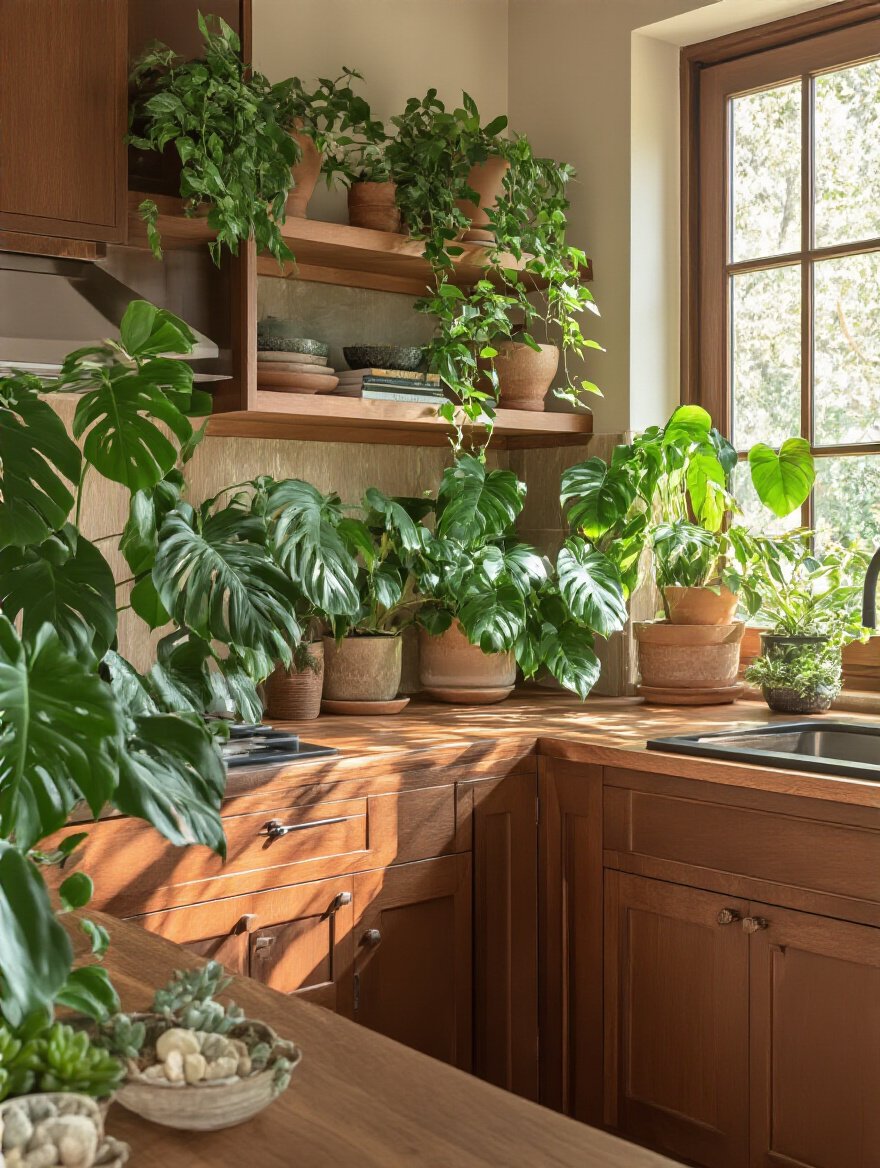
You don’t need to turn your kitchen into a Kew Gardens glasshouse. A simple pot of herbs on the windowsill, a collection of succulents on a shelf, or a single, dramatic fiddle-leaf fig in a corner is enough. The key is to choose plants that will actually thrive in your kitchen’s light conditions. A sad, wilting plant is far more depressing than no plant at all.
Finally, we arrive at the finishing touches that truly make a space your own.
Signature Touches: Unique Brown Applications & Styling
These are the final, personal layers that transform your kitchen from a well-designed space into a true reflection of your home and style. This is about adding comfort, personality, and those unique details that bring a room to life.
16. Add Distressed Leather Bar Stools for Comfortable, Chic Seating
There is little that is more inviting than the supple, worn-in comfort of distressed leather. Adding a few leather bar stools to your island is a brilliant way to introduce another layer of brown texture that is both sophisticated and incredibly comfortable. It beckons people to sit down, pour a glass of wine, and stay for a while. It’s seating that has a story.

The beauty of distressed leather is that it only gets better with age, developing a rich patina over time. It’s a material that embraces life rather than resisting it. When choosing, consider the style. A sleek metal frame will lend an industrial air, while a wooden base feels more rustic and traditional. They are an investment, but one that will pay dividends in comfort and character for years to come.
From subtle texture, let’s consider a truly bold statement.
17. Paint a Bold Chocolate Brown Accent Wall for Dramatic Depth
This might sound counterintuitive, but painting a single wall in a deep, rich chocolate brown can actually make a room feel larger. It’s an old theatrical trick. Dark colours recede from the eye, creating an illusion of depth. It’s a confident, dramatic move that can ground a kitchen and create an incredibly cozy, enveloping feel, especially in a dining nook or behind some open shelving.

The secret is to choose a wall that can handle the drama—ideally a solid wall that will become a clear focal point. This deep, velvety backdrop will make any artwork, lighter-coloured shelving, or metallic sconces placed upon it look incredibly striking. Use a paint with a matte or eggshell finish to get that rich, non-reflective quality that feels so luxurious.
From the walls to the smallest details that make a huge difference.
18. Utilize Matte Black Hardware to Give Brown an Industrial Edge
If gold and brass are the glamorous jewelry of a kitchen, matte black is the cool, defining eyeliner. Pairing brown cabinetry, especially a lighter or mid-toned wood like oak, with sleek matte black hardware creates an instant, modern-industrial edge. It’s a crisp, graphic combination that feels utterly contemporary without being cold.
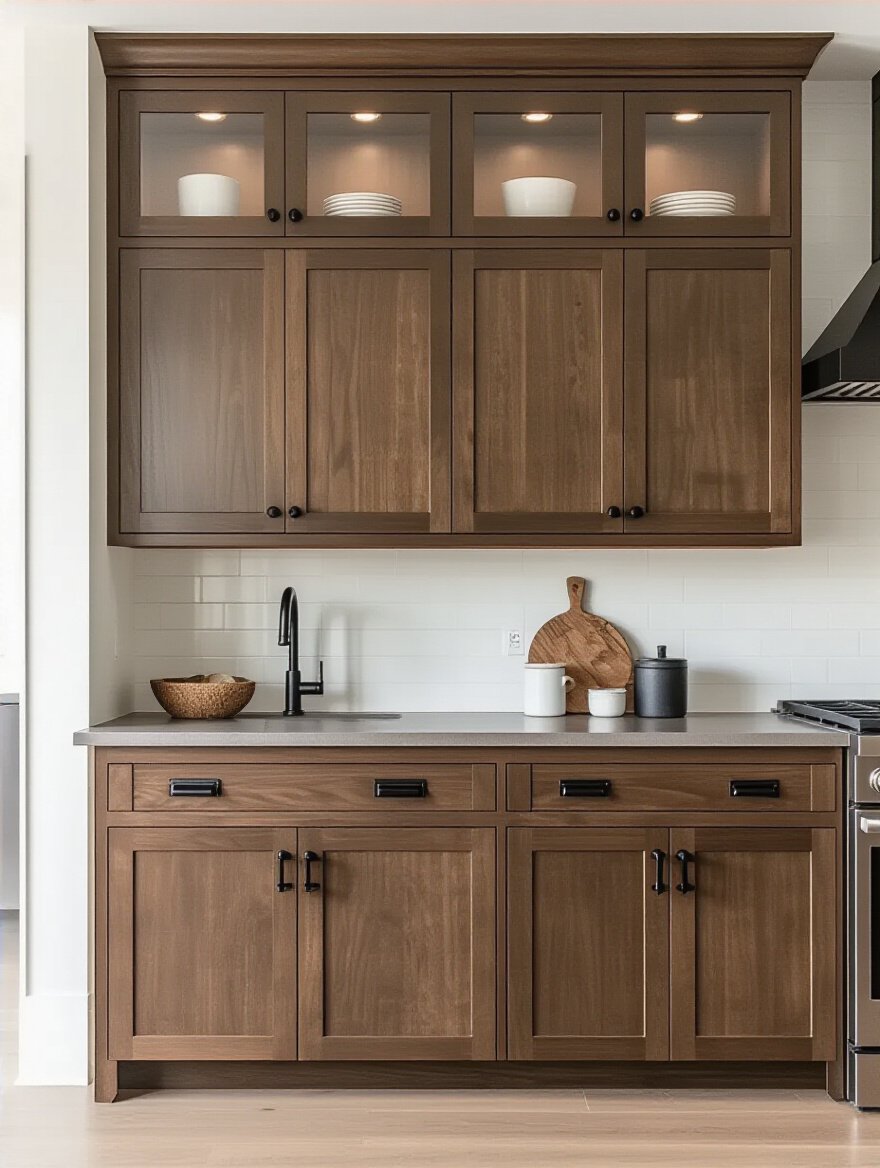
The stark contrast provides a definition that makes the cabinets pop. It’s a simple, and relatively inexpensive, update that can completely transform the feel of a kitchen. To really lean into the look, you can coordinate your hardware with a matte black tap and industrial-style pendant lights. It creates a cohesive and powerful design statement.
Let’s now soften that edge with a touch of the handmade.
19. Integrate Earthy Clay Pots and Ceramics for Organic Flair
In a world of sleek, engineered surfaces, there is a deep need for the touch of the human hand. Integrating earthy, unglazed, or subtly glazed ceramics and clay pots is a wonderful way to bring an organic, authentic quality to your brown kitchen. A collection of pottery in varying shades of terracotta, sand, and stone adds a textural richness that is both grounding and beautiful.
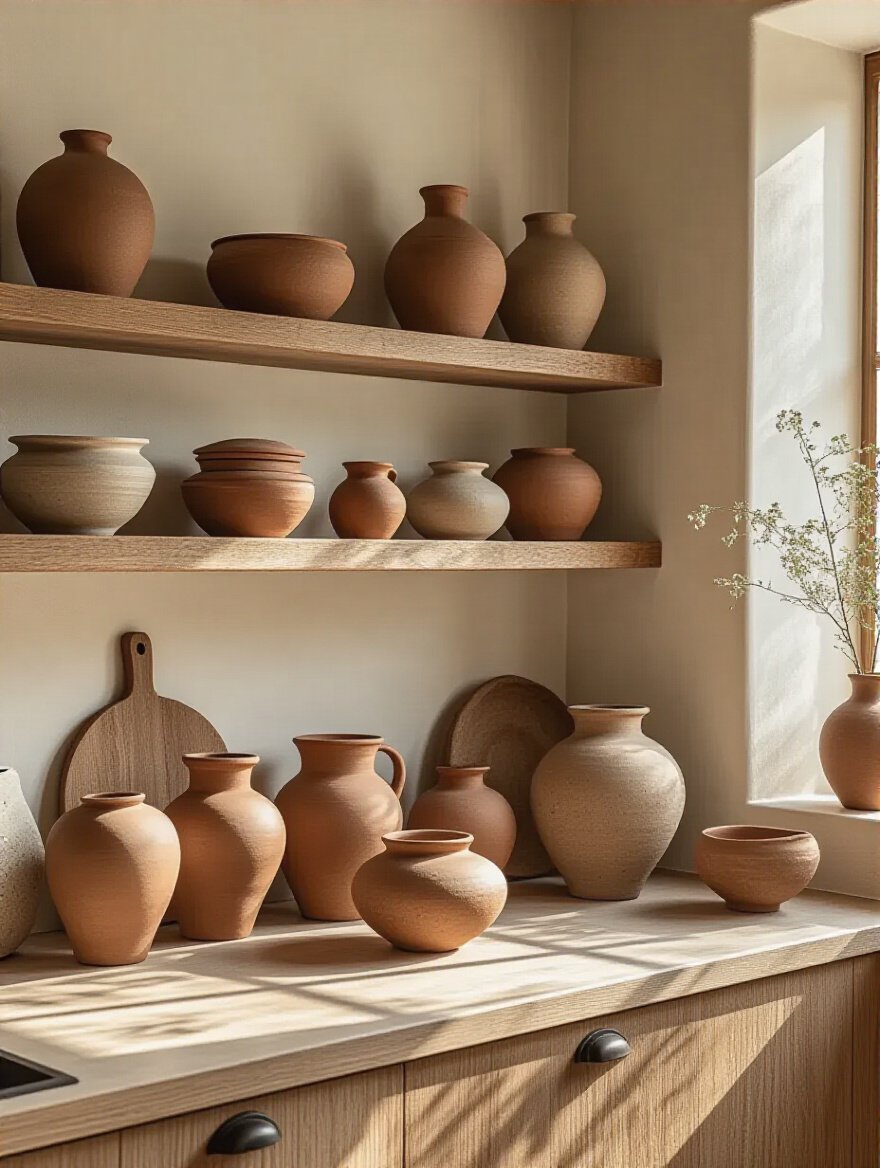
Use them for practical purposes—a large pot to hold wooden spoons, a small dish for sea salt next to the hob—or simply as decorative objects. The key is to embrace their imperfection. The subtle variations in handmade pottery are what give it its soul. It’s a quiet nod to the wabi-sabi philosophy, finding beauty in the beautifully imperfect.
And for our final flourish, let’s add a layer of softness underfoot and in hand.
20. Introduce Textured Rugs and Linens in Tonal Browns
The final touch in creating a truly inviting brown kitchen is the addition of soft textiles. A kitchen is full of hard surfaces, and adding a textured rug or some beautiful linen tea towels can make a world of difference. It softens the room, absorbs sound, and adds that last, crucial layer of comfort and visual interest. A runner in a natural jute or a durable, low-pile wool can define a walkway and feel wonderful underfoot.

Choose textiles in a range of brown tones—from creamy beige to deep chocolate—to create a rich, tonal palette. A stack of linen napkins in a warm camel colour, a chunky knit throw over a banquette seat, or a simple striped cotton rug adds a layer of lived-in elegance. It’s these small, considered details that whisper “home” and complete the story of your warm, sophisticated kitchen.
Conclusion
So, you see, brown is anything but boring. It is a canvas for creating a kitchen that is rich with warmth, depth, and personality. It’s about more than just choosing a paint colour; it’s about conducting an orchestra of materials, textures, and tones. From the steadfast elegance of walnut to the tactile charm of terracotta and the gleam of burnished brass, each element plays its part in building a space that feels both timeless and deeply personal.
Your kitchen should be a sanctuary, the undeniable heart of your home where meals are made and memories are forged. By embracing the ideas we’ve explored, you can craft a space that transcends fleeting trends and instead invests in enduring style and comfort. So go on, be brave. Dive into the magnificent spectrum of brown and create a kitchen that wraps you in a sophisticated, welcoming embrace every time you step into it. The journey starts now.
